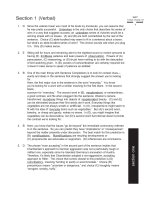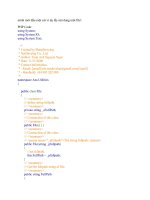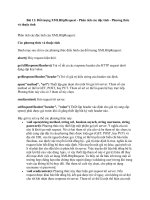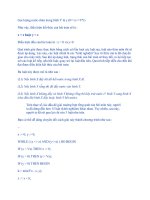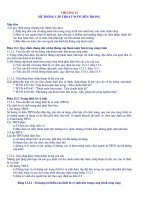MEDICINE MEETS VIRTUAL REALITY 13 pdf
Bạn đang xem bản rút gọn của tài liệu. Xem và tải ngay bản đầy đủ của tài liệu tại đây (14.39 MB, 660 trang )
MEDICINE MEETS VIRTUAL REALITY 13
Studies in Health Technology and
Informatics
This book series was started in 1990 to promote research conducted under the auspices
of the EC programmes Advanced Informatics in Medicine (AIM) and Biomedical and
Health Research (BHR), bioengineering branch. A driving aspect of international health
informatics is that telecommunication technology, rehabilitative technology, intelligent
home technology and many other components are moving together and form one inte-
grated world of information and communication media.
The complete series has been accepted in Medline. In the future, the SHTI series will
be available online.
Series Editors:
Dr. J.P. Christensen, Prof. G. de Moor, Prof. A. Hasman, Prof. L. Hunter,
Dr. I. Iakovidis, Dr. Z. Kolitsi, Dr. Olivier Le Dour, Dr. Andreas Lymberis, Dr. Peter
Niederer, Prof. A. Pedotti, Prof. O. Rienhoff, Prof. F.H. Roger France, Dr. N. Rossing,
Prof. N. Saranummi, Dr. E.R. Siegel and Dr. Petra Wilson
Volume 111
Recently published in this series
Vol. 110. F.H. Roger France, E. De Clercq, G. De Moor and J. van der Lei (Eds.), Health
Continuum and Data Exchange in Belgium and in the Netherlands – Proceed-
ings of Medical Informatics Congress (MIC 2004) & 5th Belgian e-Health
Conference
Vol. 109. E.J.S. Hovenga and J. Mantas (Eds.), Global Health Informatics Education
Vol. 108. A. Lymberis and D. de Rossi (Eds.), Wearable eHealth Systems for Person-
alised Health Management – State of the Art and Future Challenges
Vol. 107. M. Fieschi, E. Coiera and Y C.J. Li (Eds.), MEDINFO 2004 – Proceedings of
the 11th World Congress on Medical Informatics
Vol. 106. G. Demiris (Ed.), e-Health: Current Status and Future Trends
Vol. 105. M. Duplaga, K. Zieli
´
nski and D. Ingram (Eds.), Transformation of Healthcare
with Information Technologies
Vol. 104. R. Latifi (Ed.), Establishing Telemedicine in Developing Countries: From In-
ception to Implementation
Vol. 103. L. Bos, S. Laxminarayan and A. Marsh (Eds.), Medical and Care Compune-
tics 1
Vol. 102. D.M. Pisanelli (Ed.), Ontologies in Medicine
Vol. 101. K. Kaiser, S. Miksch and S.W. Tu (Eds.), Computer-based Support for Clinical
Guidelines and Protocols – Proceedings of the Symposium on Computerized
Guidelines and Protocols (CGP 2004)
Vol. 100. I. Iakovidis, P. Wilson and J.C. Healy (Eds.), E-Health – Current Situation and
Examples of Implemented and Beneficial E-Health Applications
ISSN 0926-9630
Medicine Meets
Virtual Reality 13
The Magical Next Becomes the Medical Now
Edited by
James D. Westwood
Randy S. Haluck MD FACS
Helene M. Hoffman PhD
Greg T. Mogel MD
Roger Phillips PhD CEng MBCS
Richard A. Robb PhD
Kirby G. Vosburgh PhD
Amsterdam • Berlin • Oxford • Tokyo • Washington, DC
© The authors mentioned in the table of contents
All rights reserved. No part of this book may be reproduced, stored in a retrieval system,
or transmitted, in any form or by any means, without prior written permission from the
publisher.
ISBN 1 58603 498 7
Library of Congress Control Number: 2004117290
Publisher
IOS Press
Nieuwe Hemweg 6B
1013 BG Amsterdam
The Netherlands
fax: +31 20 620 3419
e-mail:
Distributor in the UK and Ireland Distributor in the USA and Canada
IOS Press/Lavis Marketing IOS Press, Inc.
73 Lime Walk 4502 Rachael Manor Drive
Headington Fairfax, VA 22032
Oxford OX3 7AD USA
England fax: +1 703 323 3668
fax: +44 1865 750079 e-mail:
LEGAL NOTICE
The publisher is not responsible for the use which might be made of the following infor-
mation.
PRINTED IN THE NETHERLANDS
Medicine Meets Virtual Reality 13
J ames D. Westwood et al. (Eds.)
IOS Press, 2005
v
Preface
The Magical Next Becomes
the Medical Now
James D. WESTWOOD and Karen S. MORGAN
Aligned Management Associates, Inc.
Magical describes conditions that are outside our understanding of cause and effect.
What cannotbe attributed to humanor natural forces is explained as magic: super-human,
super-natural will. Even in modern societies, magic-based explanations are powerful be-
cause, given the complexity of the universe, there are so many opportunities to use them.
The history of medicine is defined by progress in understanding the human body –
from magical explanations to measurable results. Metaphysics was abandoned when
evidence-based models provided better r esults in the alleviation of physical suffering.
The pioneers of medicine demonstrated that when we relinquish magic, we gain more
reliable control over ourselves.
In the 16th century, religious prohibitions against dissection were overturned, al-
lowing surgeons to explore the interior of the human body first-hand and learn by di-
rect observation and experimentation. No one can deny that, in the years since, surgical
outcomes have improved tremendously.
However, change is marked by conflict: medical politicking, prohibitions, and pun-
ishments continue unabated. Certain new technologies are highly controversial, includ-
ing somatic cell nuclear transfer (therapeutic cloning) and embryonic stem cell research.
Lawmakers are deliberating how to control them. The conflict between science and re-
ligion still affects the practice of medicine and how reliably we will alleviate human
suffering.
To continue medical progress, physicians and scientists must openly question tra-
ditional models. Valid inquiry demands a willingness to consider all possible solutions
without prejudice. Medical politics should not perpetuate unproven assumptions nor cur-
tail reasoned experimentation, unbiased measurement, and well-informed analysis.
*****
For thirteen years, MMVR has been an incubator for technologies that create new med-
ical understanding via the simulation, visualization, and extension of reality. Researchers
create imaginary patients because they offer a more reliable and controllable experience
to the novice surgeon. With imaging tools, reality is purposefully distorted to reveal to
the clinician what the eye alone cannot see. Robotics and intelligence networks allow
the healer’s sight, hearing, touch, and judgment to be extended across distance, as if by
magic.
vi Preface
At MMVR, research progress is sometimes incremental. This can be frustrating: one
would like progress to be easy, steady, an d predictable. Wouldn’t it be miraculous if
revolutions happened right on schedule?
But this is the real magic: the “Eureka!” moments when scientific truth is suddenly
revealed after lengthy observation, experimentation, and measurement. These moments
are not miraculous, however. They are human ingenuity in progress and they are docu-
mented here in this book.
MMVR researchers can be proud of the progress of thirteen years – transforming
the medical next in to the medical now. They should take satisfaction in accomplishments
made as individuals and as a community. It is an honor for us, the conference organizers,
to perpetuate MMVR as a forum where researchers share their eureka moments with
their colleagues and the world.
Thank you for your magic.
vii
MMVR13 Proceedings Editors
James D. Westwood
MMVR Program Coordinator
Aligned Management Associates, Inc.
Randy S. Haluck MD FACS
Director of Minimally Invasive Surgery
Director of Surgical Simulation
Associate Professor of Surgery
Penn State, Hershey Medical Center
Helene M. Hoffman PhD
Assistant Dean, Educational Computing
Adjunct Professor of Medicine
Division of Medical Education
School of Medicine
University of California, San Diego
Greg T. Mogel MD
Assistant Professor o f Radiology and Biomedical Engineering
University of Southern California;
Director, TATRC-W
U.S. Army Medical Research & Materiel Command
Roger Phillips PhD CEng MBCS
Research Professor, Simulation & Visualization Group
Director, Hull Immersive Visualization Environment (HIVE)
Department of Computer Science
University of Hull (UK)
Richard A. Robb PhD
Scheller Professor in Medical Research
Professor of Biophysics & Computer Science
Director, Mayo Biomedical Imaging Resource
Mayo Clinic College of Medicine
Kirby G. Vosburgh PhD
Associate Director, Center for In tegration of Medicin e and
Innovative Technology (CIMIT)
Massachusetts General Hospital
Harvard Medical School
viii Conference Organization
MMVR13 Organizing Commit tee
Michael J. Ackerman PhD
High Performance Computing & Communications,
National Library of Medicine
Ian Alger MD
New York Presbyterian Hospital;
Weill Medical College of Cornell University
David C. Balch MA
DCB Consulting LLC
Steve Charles MD
MicroDexterity Systems;
University of Tennessee
Patrick C. Cregan FRACS
Nepean Hosp ital,
Wentworth Area Health Service
Henry Fuchs PhD
Dept of Computer Science,
University of North Carolina
Walter J. Greenleaf PhD
Greenleaf Medical Systems
Randy S. Haluck MD FACS
Dept of Surgery,
Penn State College of Medicine
David M. Hananel
Surgical Programs,
Medical Education Technologies Inc.
Wm. LeRoy Heinrichs MD PhD
Medical Media & Information Technologies/ Gynecology & Obstetrics,
Stanford University School of Medicine
Helene M. Hoffman PhD
School of Medicine,
University of California, San Diego
Heinz U. Lemke PhD
Institute for Technical Informatics,
Technical University Berlin
Alan Liu PhD
National Capital Area Medical Simulation Center,
Uniformed Services University
Conference Organization ix
Greg T. Mogel MD
University of Southern California;
TATRC/USAMRMC
Kevin N. Montgomery PhD
National Biocomputation Center,
Stanford University
Makoto Nonaka MD PhD
Foundation for International Scientific Advancement
Roger Phillips PhD CEng MBCS
Dept of Computer Science,
University of Hull (UK)
Richard A. Robb PhD
Mayo Biomedical Imaging Resource,
Mayo Clinic College of Medicine
Jannick P. Rolland PhD
ODA Lab, School of Optics / CREOL,
University of Central Florida
Ajit K. Sachdeva MD FRCSC FACS
Division of Education,
American College of Surgeons
Richard M. Satava MD FACS
Dept of Surgery, University of Washington;
DARPA; TATRC/USAMRMC
Rainer M.M. Seibel MD
Diagnostic & Interventional Radiology,
University of Witten/Herdecke
Steven Senger PhD
Dept of Computer Science,
University of Wisconsin - La Crosse
Ramin Shahidi PhD
Image Guidance Laboratories,
Stanford University School of Medicine
Faina Shtern MD
Beth Israel Deaconess; Children’s Medical Center;
Harvard Medical School
Don Stredney
Interface Laboratory,
OSC
x Conference Organization
Julie A. Swain MD
Cardiovascular and Respiratory Devices,
U.S. Food and Drug Administration
Kirby G. Vosburgh PhD
CIMIT; Massachusetts General Hospital;
Harvard Medical School
Dave Warner MD PhD
MindTel LLC;
Institute for In terventio nal Informatics
Suzanne J. Weghorst MA MS
Human Interface Technology Lab,
University of Washington
Mark D. Wiederhold MD PhD FACP
The Virtual Reality Medical Center
xi
Contents
Preface v
Conference Organization vii
Dynamic Generation of Surgery Specific Simulators – A Feasibility Study 1
Eric Acosta and Bharti Temkin
Haptic Laparoscopic Skills Trainer with Practical User Evaluation Metrics 8
Eric Acosta and Bharti Temkin
Desktop and Conference Room VR for Physicians 12
Zhuming Ai and Mary Rasmussen
A Biologically Derived Approach to Tissue Modeling 15
Tim Andersen, Tim Otter, Cap Petschulat, Ullysses Eoff, Tom Menten,
Robert Davis and Bill Crowley
Grid Enabled Remote Visualization of Medical Datasets 22
Nick J. Avis, Ian J. Grimstead and David W. Walker
Surface Scanning Soft Tissues 29
Nick J. Avis, John McClure and Frederic Kleinermann
Validation of a Bovine Rectal Palpation Simulator for Training Veterinary
Students 33
Sarah Baillie, Andrew Crossan, Stephen Brewster, Dominic Mellor
and Stuart Reid
Predictive Biosimulation and Virtual Patients in Pharmaceutical R&D 37
Alex Bangs
Simulating Surgical Incisions without Polygon Subdivision 43
Yogendra Bhasin, Alan Liu and Mark Bowyer
3D Real-time FEM Based Guide Wire Simulator with Force Feedback 50
Suraj Bhat, Chandresh Mehta, Clive D’Souza and T. Kesavadas
Determining the Efficacy of an Immersive Trainer for Arthroscopy Skills 54
James P. Bliss, Hope S. Hanner-Bailey and Mark W. Scerbo
Teaching Intravenous Cannulation to Medical Students: Comparative
Analysis of Two Simulators and Two Traditional Educational Approaches 57
Mark W. Bowyer, Elisabeth A. Pimentel, Jennifer B. Fellows,
Ryan L. Scofield, Vincent L. Ackerman, Patrick E. Horne, Alan V. Liu,
Gerald R. Schwartz and Mark W. Scerbo
xii Contents
Validation of SimPL – A Simulator for Diagnostic Peritoneal Lavage Training 64
Colonel Mark W. Bowyer, Alan V. Liu and James P. Bonar
Challenges in Presenting High Dimensional Data to aid in Triage in the
DARPA Virtual Soldier Project 68
A.D. Boyd, Z.C. Wright, A.S. Ade, F. Bookstein, J.C. Ogden, W. Meixner,
B.D. Athey and T. Morris
A Web-based Remote Collaborative System for Visualization and Assessment
of Semi-Automatic Diagnosis of Liver Cancer from CT Images 75
Alexandra Branzan Albu, Denis Laurendeau, Marco Gurtner
and Cedric Martel
Heterogeneous Displays for Surgery and Surgical Simulation 79
Jesus Caban, W. Brent Seales and Adrian Park
Visualization of Treatment Evolution Using Hardware-Accelerated Morphs 83
Bruno M. Carvalho and H. Quynh Dihn
Real-time Rendering of Radially Distorted Virtual Scenes for Endoscopic
Image Augmentation 87
M.S. Chen, R.J. Lapeer and R.S. Rowland
Tracking the Domain: The Medical Modeling and Simulation Database 90
C. Donald Combs and Kara Friend
The ViCCU Project – Achieving Virtual Presence using Ultrabroadband
Internet in a Critical Clinical Application – Initial Results 94
Patrick Cregan, Stuart Stapleton, Laurie Wilson, Rong-Yiu Qiao, Jane Lii
and Terry Percival
High Stakes Assessment Using Simulation – An Australian Experience 99
Patrick Cregan and Leonie Watterson
The Virtual Pediatric Standardized Patient Application: Formative Evaluation
Findings 105
Robin Deterding, Cheri Milliron and Robert Hubal
The Visible Human and Digital Anatomy Learning Initiative 108
Parvati Dev and Steven Senger
Laparoscopic Task Recognition Using Hidden Markov Models 115
Aristotelis Dosis, Fernando Bello, Duncan Gillies, Shabnam Undre,
Rajesh Aggarwal and Ara Darzi
Intraoperative Augmented Reality: The Surgeons View 123
Georg Eggers, Tobias Salb, Harald Hoppe, Lüder Kahrs, Sassan Ghanai,
Gunther Sudra, Jörg Raczkowsky, Rüdiger Dillmann, Heinz Wörn,
Stefan Hassfeld and Rüdiger Marmulla
Contents xiii
A Vision-Based Surgical Tool Tracking Approach for Untethered Surgery
Simulation and Training 126
James English, Chu-Yin Chang, Neil Tardella and Jianjuen Hu
Haptic Simulation of the Milling Process in Temporal Bone Operations 133
Magnus Eriksson, Henrik Flemmer and Jan Wikander
Soft Tissue Deformation using a Nonlinear Hierarchical Finite Element Model
with Real-Time Online Refinement 137
Alessandro Faraci, Fernando Bello and Ara Darzi
Modeling Biologic Soft Tissues for Haptic Feedback with an Hybrid
Multiresolution Method 145
Antonio Frisoli, Luigi Borelli and Massimo Bergamasco
Control of Laparoscopic Instrument Motion in an Inanimate Bench Model:
Implications for the Training and Evaluation of Technical Skills 149
David Gonzalez, Heather Carnahan, Monate Praamsma, Helen Macrae
and Adam Dubrowski
Tearing of Membranes for Interactive Real-Time Surgical Training 153
Johannes Grimm
Interactive Real-Time Simulation of an Endoscopic Polyp Removal 160
Johannes Grimm
Surgical Robot Setup Simulation with Consistent Kinematics and Haptics for
Abdominal Surgery 164
Mitsuhiro Hayashibe, Naoki Suzuki, Asaki Hattori, Shigeyuki Suzuki,
Kozo Konishi, Yoshihiro Kakeji and Makoto Hashizume
Development of a Navigation Function for an Endosocopic Robot Surgery
System 167
Asaki Hattori, Naoki Suzuki, Mitsuhiro Hayashibe, Shigeyuki Suzuki,
Yoshito Otake, Hisao Tajiri and Susumu Kobayashi
Development of a 3D Visualization System for Surgical Field Deformation
with Geometric Pattern Projection 172
Mitsuhiro Hayashibe, Naoki Suzuki, Susumu Kobayashi, Norio Nakata,
Asaki Hattori and Yoshihiko Nakamura
In Vivo Force During Arterial Interventional Radiology Needle Puncture
Procedures 178
Andrew E. Healey, Jonathan C. Evans, Micheal G. Murphy, Steven Powell,
Thien V. How, David Groves, Fraser Hatfield, Bernard M. Diaz
and Derek A. Gould
The Virtual Terrorism Response Academy: Training for High-Risk,
Low-Frequency Threats 185
Joseph V. Henderson
xiv Contents
Real-Time Ultrasonography Simulator Based on 3D CT-Scan Images 191
Alexandre Hostettler, Clément Forest, Antonello Forgione, Luc Soler
and Jacques Marescaux
Fuzzy Classification: Towards Evaluating Performance on a Surgical
Simulator 194
Jeff Huang, Shahram Payandeh, Peter Doris and Ima Hajshirmohammadi
Structural Flexibility of Laparoscopic Instruments: Implication for the Design
of Virtual Reality Simulators 201
Scott Hughes, James Larmer, Jason Park, Helen Macrae
and Adam Dubrowski
A Networked Haptic Virtual Environment for Teaching Temporal Bone
Surgery 204
Matthew Hutchins, Stephen O’Leary, Duncan Stevenson, Chris Gunn
and Alexander Krumpholz
Real-Time Haptic Interface for VR Colonoscopy Simulation 208
Dejan Ilic, Thomas Moix, Nial Mc Cullough, Lindo Duratti, Ivan Vecerina
and Hannes Bleuler
Computational Simulation of Penetrating Trauma in Biological Soft Tissues
using the Material Point Method 213
Irina Ionescu, James Guilkey, Martin Berzins, Robert M. Kirby
and Jeffrey Weiss
Adaptive Soft Tissue Deformation for a Virtual Reality Surgical Trainer 219
Lenka Jerabkova, Timm P. Wolter, Norbert Pallua and Torsten Kuhlen
Simulation of Color Deficiency in Virtual Reality 223
Bei Jin, Zhuming Ai and Mary Rasmussen
Improving the Visual Realism of Virtual Surgery 227
Wei Jin, Yi-Je Lim, Xie George Xu, Tejinder P. Singh and Suvranu De
ChiroSensor – An Array of Non-Invasive sEMG Electrodes 234
E.A. Jonckheere, P. Lohsoonthorn and V. Mahajan
Multiple Contact Approach to Collision Modelling in Surgical Simulation 237
Bhautik Joshi, Bryan Lee, Dan C. Popescu and Sébastien Ourselin
Visualization of Surgical 3D Information with Projector-based Augmented
Reality 243
Lüder Alexander Kahrs, Harald Hoppe, Georg Eggers, Jörg Raczkowsky,
Rüdiger Marmulla and Heinz Wörn
Facial Plastic Surgery Planning Using a 3D Surface Deformation Tool 247
Zacharoula Kavagiou, Fernando Bello, Greg Scott, Juian Hamann
and David Roberts
Contents xv
The Haptic Kymograph: A Diagnostic Tele-Haptic Device for Sensation of
Vital Signs 251
Youngseok Kim and T. Kesavadas
A Study of the Method of the Video Image Presentation for the Manipulation
of Forceps 255
Soichi Kono, Toshiharu Sekioka, Katsuya Matsunaga, Kazunori Shidoji
and Yuji Matsuki
Collaborative Biomedical Data Exploration in Distributed Virtual
Environments 259
Falko Kuester, Zhiyu He, Jason Kimball, Marc Antonijuan Tresens
and Melvin Quintos
FEM-Based Soft Tissue Destruction Model for Ablation Simulator 263
Naoto Kume, Megumi Nakao, Tomohiro Kuroda, Hiroyuki Yoshihara
and Masaru Komori
The VREST Learning Environment 270
E.E. Kunst, R.H. Geelkerken and A.J.B. Sanders
MVL: Medical VR Simulation Library 273
Yoshihiro Kuroda, Megumi Nakao, Tomohiro Kuroda, Hiroshi Oyama
and Hiroyuki Yoshihara
Haptic Device for Colonoscopy Training Simulator 277
Jun Yong Kwon, Hyun Soo Woo and Doo Yong Lee
Developing a Simulation-Based Training Program for Medical First
Responders 280
Fuji Lai, Eileen Entin, Meghan Dierks, Daniel Raemer and Robert Simon
A Mechanical Contact Model for the Simulation of Obstetric Forceps Delivery
in a Virtual/Augmented Environment 284
R.J. Lapeer
Instant Electronic Patient Data Input During Emergency Response in Major
Disaster Setting: Report on the Use of a Rugged Wearable (Handheld) Device
and the Concept of Information Flow throughout the Deployment of the
Disaster Response upon Hospital Admission 290
Christophe Laurent and Luc Beaucourt
Remote Console for Virtual Telerehabilitation 294
Jeffrey A. Lewis, Rares F. Boian, Grigore Burdea and Judith E. Deutsch
Improved Virtual Surgical Cutting Based on Physical Experiments 301
Yi-Je Lim, Daniel B. Jones and Suvranu De
A Haptic-Enabled Simulator for Cricothyroidotomy 308
Alan Liu, Yogendra Bhasin and Mark Bowyer
xvi Contents
The Mini-Screen: An Innovative Device for Computer Assisted Surgery
Systems 314
Benoit Mansoux, Laurence Nigay and Jocelyne Troccaz
Real-time Visualization of Cross-sectional Data in Three Dimensions 321
Terrence J. Mayes, Theodore T. Foley, Joseph A. Hamilton
and Tom C. Duncavage
Compressing Different Anatomical Data Types for the Virtual Soldier 325
Tom Menten, Xiao Zhang, Lian Zhu and Marc Footen
A Real-Time Haptic Interface for Interventional Radiology Procedures 329
Thomas Moix, Dejan Ilic, Blaise Fracheboud, Jurjen Zoethout
and Hannes Bleuler
An Interactive Simulation Environment for Craniofacial Surgical Procedures 334
Dan Morris, Sabine Girod, Federico Barbagli and Kenneth Salisbury
A GPU Accelerated Spring Mass System for Surgical Simulation 342
Jesper Mosegaard, Peder Herborg and Thomas Sangild Sørensen
Interactive 3D Region Extraction of Volume Data Using Deformable
Boundary Object 349
Megumi Nakao, Takakazu Watanabe, Tomohiro Kuroda
and Hiroyuki Yoshihara
Virtual Surgical Telesimulations in Otolaryngology 353
Andrés A. Navarro Newball, Carlos J. Hernández, Jorge A. Velez,
Luis E. Munera, Gregorio B. García, Carlos A. Gamboa
and Antonio J. Reyes
Emerging Technologies for Bioweapons Defense 356
Sinh Nguyen, Joseph M. Rosen and C. Everett Koop
Assessment of Brain Activities in Immersive Environments 362
Max M. North, Sarah M. North, John Crunk and Jeff Singleton
Evaluation of 3D Airway Imaging of Obstructive Sleep Apnea with
Cone-beam Computed Tomography 365
Takumi Ogawa, Reyes Enciso, Ahmed Memon, James K. Mah
and Glenn T. Clark
Multi-Sensory Surgical Support System Incorporating, Tactile, Visual
and Auditory Perception Modalities 369
Sadao Omata, Yoshinobu Murayama and Christos E. Constantinou
Estimation of Dislocation after Total Hip Arthroplasty by 4-Dimensional 372
Yoshito Otake, Naoki Suzuki, Asaki Hattori, Hidenobu Miki,
Mitsuyoshi Yamamura, Nobuo Nakamura, Nobuhiko Sugano,
Kazuo Yonenobu and Takahiro Ochi
Contents xvii
BrainTrain: Brain Simulator for Medical VR Application 378
Bundit Panchaphongsaphak, Rainer Burgkart and Robert Riener
Smart Tutor: A Pilot Study of a Novel Adaptive Simulation Environment 385
Thai Pham, Lincoln Roland, K. Aaron Benson, Roger W. Webster,
Anthony G. Gallagher and Randy S. Haluck
Immersive Visualization Training of Radiotherapy Treatment 390
Roger Phillips, James W. Ward and Andy W. Beavis
Toward In Vivo Mobility 397
Mark E. Rentschler, Jason Dumpert, Stephen R. Platt, Shane M. Farritor
and Dmitry Oleynikov
E-Learning Experience: A Teaching Model with Undergraduate Surgery
Students in a Developing Country 404
Rafael E. Riveros, Andres Espinosa, Pablo Jimenez and Luis Martinez
Development of a VR Therapy Application for Iraq War Military Personnel
with PTSD 407
Albert Rizzo, Jarrell Pair, Peter J. Mcnerney, Ernie Eastlund,
Brian Manson, Jon Gratch, Randy Hill and Bill Swartout
The LapSim: A Learning Environment for Both Experts and Novices 414
Charles Y. Ro, Ioannis K. Toumpoulis, Robert C. Ashton, Tony Jebara,
Caroline Schulman, George J. Todd, Joseph J. Derose
and James J. McGinty
A Novel Drill Set for the Enhancement and Assessment of Robotic Surgical
Performance 418
Charles Y. Ro, Ioannis K. Toumpoulis, Robert C. Ashton, Celina Imielinska,
Tony Jebara, Seung H. Shin, J.D. Zipkin, James J. McGinty, George J. Todd
and Joseph J. Derose
Spherical Mechanism Analysis of a Surgical Robot for Minimally Invasive
Surgery – Analytical and Experimental Approaches 422
Jacob Rosen, Mitch Lum, Denny Trimble, Blake Hannaford
and Mika Sinanan
Using an Ontology of Human Anatomy to Inform Reasoning with Geometric
Models 429
Daniel L. Rubin, Yasser Bashir, David Grossman, Parvati Dev
and Mark A. Musen
Assessing Surgical Skill Training Under Hazardous Conditions in a Virtual
Environment 436
Mark W. Scerbo, James P. Bliss, Elizabeth A. Schmidt,
Hope S. Hanner-Bailey and Leonard J. Weireter
xviii Contents
An Automatic Robust Meshing Algorithm for Soft Tissue Modeling 443
Sascha Seifert, Sandro Boehler, Gunther Sudra and Rüdiger Dillmann
Visualizing Volumetric Data Sets Using a Wireless Handheld Computer 447
Steven Senger
Quantifying Risky Behavior in Surgical Simulation 451
Christopher Sewell, Dan Morris, Nikolas Blevins, Federico Barbagli
and Kenneth Salisbury
Haptic Herniorrhaphy Simulation with Robust and Fast Collision Detection
Algorithm 458
Yunhe Shen, Venkat Devarajan and Robert Eberhart
Affordable Virtual Environments: Building a Virtual Beach for Clinical Use 465
Andrei Sherstyuk, Christoph Aschwanden and Stanley Saiki
Analysis of Masticatory Muscle Condition Using the 4-dimensional Muscle
Model for a Patient with Square Mandible 468
Yuhko Shigeta, Takumi Ogawa, Eriko Ando, Shunji Fukushima,
Naoki Suzuki, Yoshito Otake and Asaki Hattori
Automated Renderer for Visible Human and Volumetric Scan Segmentations 473
Jonathan C. Silverstein, Victor Tsirline, Fred Dech, Philip Kouchoukos
and Peter Jurek
Distributed Collaborative Radiological Visualization using Access Grid 477
Jonathan C. Silverstein, Fred Dech, Justin Binns, David Jones,
Michael E. Papka and Rick Stevens
Development of a Method for Surface and Subsurface Modeling Using Force
and Position Sensors 482
Kevin Smalley and T. Kesavadas
The Physiology and Pharmacology of Growing Old, as Shown in Body
Simulation 488
N. Ty Smith and Kenton R. Starko
Physiologic and Chemical Simulation of Cyanide and Sarin Toxicity
and Therapy 492
N. Ty Smith and Kenton R. Starko
Monitor Height Affects Surgeons’ Stress Level and Performance on
Minimally Invasive Surgery Tasks 498
Warren D. Smith, Ramon Berguer and Ninh T. Nguyen
A New Platform for Laparoscopic Training and Education 502
Vidar Sørhus, Eivind M. Eriksen, Nils Grønningsæter, Yvon Halbwachs,
Per Ø. Hvidsten, Johannes Kaasa, Kyrre Strøm, Geir Westgaard
and Jan S. Røtnes
Contents xix
Virtual Reality Testing of Multi-Modal Integration in Schizophrenic Patients 508
Anna Sorkin, Avi Peled and Daphna Weinshall
Emotional and Performance Attributes of a VR Game: A Study of Children 515
Sharon Stansfield, Carole Dennis and Evan Suma
Virtual Reality Training Improves Students’ Knowledge Structures of Medical
Concepts 519
Susan M. Stevens, Timothy E. Goldsmith, Kenneth L. Summers,
Andrei Sherstyuk, Kathleen Kihmm, James R. Holten, Christopher Davis,
Daniel Speitel, Christina Maris, Randall Stewart, David Wilks,
Linda Saland, Diane Wax, Panaiotis, Stanley Saiki, Dale Alverson
and Thomas P. Caudell
Emphatic, Interactive Volume Rendering to Support Variance in User
Expertise 526
Don Stredney, David S. Ebert, Nikolai Svakhine, Jason Bryan,
Dennis Sessanna and Gregory J. Wiet
First Clinical Tests with the Augmented Reality System INPRES 532
Gunther Sudra, Rüdiger Marmulla, Tobias Salb, Sassan Ghanai,
Georg Eggers, Bjoern Giesler, Stefan Hassfeld, Joachim Muehling
and Ruediger Dillmann
Construction of a High-Tech Operating Room for Image-Guided Surgery
using VR 538
Naoki Suzuki, Asaki Hattori, Shigeyuki Suzuki, Yoshito Otake,
Mitsuhiro Hayashibe, Susumu Kobayashi, Takehiko Nezu, Haruo Sakai
and Yuji Umezawa
Tele-Surgical Simulation System for Training in the Use of da Vinci
TM
Surgery 543
Shigeyuki Suzuki, Naoki Suzuki, Mitsuhiro Hayashibe, Asaki Hattori,
Kozo Konishi, Yoshihiro Kakeji and Makoto Hashizume
Homeland Security and Virtual Reality: Building a Strategic Adaptive
Response System (STARS) 549
Christopher Swift, Joseph M. Rosen, Gordon Boezer, Jaron Lanier,
Joseph V. Henderson, Alan Liu, Ronald C. Merrell, Sinh Nguyen,
Alex Demas, Elliot B. Grigg, Matthew F. McKnight, Janelle Chang
and C. Everett Koop
Haptic Interaction and Visualization of Elastic Deformation 556
F. Tavakkoli Attar, R.V. Patel and M. Moallem
Segmenting Deformable Surface Models Using Haptic Feedback 560
Praveen Thiagarajan, Pei Chen, Karl Steiner, Guang Gao
and Kenneth Barner
xx Contents
Parametric Model of the Scala Tympani for Haptic-Rendered Cochlear
Implantation 564
Catherine Todd and Fazel Naghdy
Three Dimensional Electromechanical Model of Porcine Heart with
Penetrating Wound Injury 568
Taras Usyk and Roy Kerckhoffs
Beyond VR: Creating the Augmented Physician 574
Kirby G. Vosburgh
Stiffness and Texture Perception for Teledermatology 579
Kenneth J. Waldron, Christopher Enedah and Hayes Gladstone
Linking Human Anatomy to Knowledgebases: A Visual Front End for
Electronic Medical Records 586
Stewart Dickson, Line Pouchard, Richard Ward, Gary Atkins, Martin Cole,
Bill Lorensen and Alexander Ade
Simulating the Continuous Curvilinear Capsulorhexis Procedure During
Cataract Surgery on the EYESI™ System 592
Roger Webster, Joseph Sassani, Rod Shenk, Matt Harris, Jesse Gerber,
Aaron Benson, John Blumenstock, Chad Billman and Randy Haluck
Using an Approximation to the Euclidean Skeleton for Efficient Collision
Detection and Tissue Deformations in Surgical Simulators 596
Roger Webster, Matt Harris, Rod Shenk, John Blumenstock, Jesse Gerber,
Chad Billman, Aaron Benson and Randy Haluck
Virtual Surgical Planning and CAD/CAM in the Treatment of Cranial Defects 599
John Winder, Ian McRitchie, Wesley McKnight and Steve Cooke
New Approaches to Computer-based Interventional Neuroradiology Training 602
Xunlei Wu, Vincent Pegoraro, Vincent Luboz, Paul F. Neumann,
Ryan Bardsley, Steven Dawson and Stephane Cotin
CAD Generated Mold for Preoperative Implant Fabrication in Cranioplasty 608
J. Wulf, L.C. Busch, T. Golz, U. Knopp, A. Giese, H. Ssenyonjo,
S. Gottschalk and K. Kramer
Effect of Binocular Stereopsis on Surgical Manipulation Performance
and Fatigue When Using a Stereoscopic Endoscope 611
Yasushi Yamauchi and Kazuhiko Shinohara
A Dynamic Friction Model for Haptic Simulation of Needle Insertion 615
Yinghui Zhang and Roger Phillips
Enhanced Pre-computed Finite Element Models for Surgical Simulation 622
Hualiang Zhong, Mark P. Wachowiak and Terry M. Peters
Contents xxi
Cardiac MR Image Segmentation and Left Ventricle Surface Reconstruction
Based on Level Set Method 629
Zeming Zhou, Jianjie You, Pheng Ann Heng and Deshen Xia
Author Index 633
This page intentionally left blank
Medicine Meets Virtual Reality 13
J ames D. Westwood et al. (Eds.)
IOS Press, 2005
1
Dynamic Generation of Surgery Specific
Simulators – A Feasibility Study
Eric ACOSTA and Bharti TEMKIN PhD.
Department of Computer Science, Texas Tech University
Department of Surgery, Texas Tech University Health Science Center
PO Box 2100, Lubbock 79409
e-mail:
Abstract. Most of the current s urgical simulators rely on preset anatomical virtual
environments (VE). The functionality of a simulator is typically fixed to anatomy-
based specific tasks. Thisrigiddesign principle makes itdifficult to reuse an exist-
ing s imulator for different surgeries. It also makes itdifficult to simulate procedures
for specific patients, since their anatomical features or anom alies cannot be eas ily
replaced in the VE.
In this paper, we demonstrate the reusability of a modular skill-based simulator,
LapSkills, which allows dynamic generat
ion of surgery-specific simulations. Task
and instrument modules are easily reused from LapSkills and the three-dimensional
VE can be replaced with other anatomical models. We build a nephrectomy simu-
lation by reusing the simulated vessels and the clipping and cutting task modules
from LapSkills. The V E of the kidney is generated with our anatomical model gen-
eration tools and then inserted into the s imulation (while preserving the established
tasks and evaluation metrics). An important benefit for the created surgery and
patient-specific simulations is that reused components remainvalidated. We plan
to use this faster development process to generate a simulation library containing
awide variety of laparoscopicsurgical simulations. Incorporating the simulations
into surgical training programs will help collect data for validating them .
1. Introduction
Virtual Reality based surgical simulators have the potential to provide training for a wide
range of surgeries with a large set of pathologies relevant for surgical training [1,2].
However, in order to fully leverage the capabilities of surgical simulators it is neces-
sary to overcom e some of the bottlenecks imposed by the complexity of developing and
validating them.
The generalized modular architecture of LapSkills [3] makes it possible to dynam-
ically generate or modify surgery and patient-specific simulations with minimum pro-
gramming. The construction process i
nvolves 1) importing or generating VE(s) with the
associated physical properties for the anatomical structures, 2) selecting tasks and instru-
ments with the associated evaluation metrics, 3) integrating the models and tasks into the
simulation, and 4) integrating the new simulation into LapSkills. This allows LapSkills
to be used as a general platform to run new simulations and collect performance data for
validating the newly built simulation.
2 E. Acosta and B. Temkin / Dynamic Generation of Surgery Specific Simulators – A Feasibility Study
Figure 1. User selection based simulation generation.
To show the feasibility of generating new simulations from LapSkills, a nephrectomy
simulation has been developed. The VE for the kidney, including vessels such as renal
artery and vein, was generated with our anatomical model generation tools and then
inserted into the simulation while preserving the established clipping and cutting tasks
and evaluation metrics. Furthermore, the VE has been interchanged with other patient
specific VEs from other m odalities, such as the Visible Hu man dataset and other patient-
specific datasets.
2. Dynamic simulation generation
Extending the capabilities of LapSkills, to also func tion as a s
imulation generator, pro-
vides the ability to rapidly create new customized and partially validated surgery and
patient-specific simulations. Various possibilities offered by this system, illustrated in
Figure 1, cover a large set of pathologies relevant for the training needs of surgeons.
Based on the desired requirements, such as surgery type, anatomy, tasks included, selec-
tion of instruments, and evaluation options, LapSkills queries its library of existing sim-
ulations to determine if the required simulation already exists
. If a match is found, the
existing simulation can be used for training. However, if the needed simu lation does not
exist then a new user specified simulation is generated and seamlessly integrated into the
simulation library to become an in tegral part of LapSkills. Interfacing several tools (de-
scribed in sections 2.2and2.3) to LapSkills makes it possible to reuse the components
of its architecture in order to create or modify simulations.
2.1. LapSkills architecture
The architecture consists of several reusable modules shown i
nFigure 2. Task modules
consist of basic subtasks that can be used to define a skill, listed in Table 1. The in-
strument module contains the simulated virtual instruments. Each task and instrument
module has built-in evaluation metri cs that are used to acquire performance data. Thus,
reusing these modules automatically incorporates the associated evaluation metrics. The
evaluation modules containdifferent evaluation models. An evaluation model determines
E. Acosta and B. Temkin / Dynamic Generation of Surgery Specific Simulators – A Feasibility Study 3
Figure 2. Architecture of LapSkills.
Tab le 1. Sample reusable subtasks
contained within task modules.
Task List
Clip <object>
Cut <object>
Extract <object>
Grasp <object>
Locate <object>
Move < object>
Touch <object>
Insert <instrument>
Withdraw <instrument>
Figure 3. Volumetric anatomical models generated from (left) the Visible Human in 75 seconds, (middle) CT
dataset in 10 seconds, and (right) 3D Ultrasound in 1 second.
how to interpret the data collected by the task and instrument metrics to evaluate the
user’s performance.
Asimulation specification file represents the task list, virtual instruments, and eval-
uation model, and describes the VE for each skill. The task list consists of a sequence(s)
of subtasks that are used to simulate the skill. The instrument and evaluation components
specify which virtual instruments and evaluation modules are used. The VE describes
which anatomical models (contained in the database) are to be used and specifies their
properties such as orientation, haptictissue properties, etc. The information stored inthe
speci
fication file isusedbythesimulation interface in order to dynamically build and
perform the skill at run - t ime.
Asimulation engine allows the simulator to step through the sequence of tasks that
are defined for a skill. It incorpor ates a state machine (which is constructed when a
simulation file is loaded) that transitions through th e list of subtasks as the user performs
them.
Several databases are utilized by LapSkills including an atomical and instrument
models, haptictissue properties that define the feel of the structures, surgery videos, and
evaluation results.
2.2. Anatomical model generation and integration tools
The anatomical models, or Virtual Body Structures (VBS), are generated from the Visi-
ble Human (vh-VBS) and patient-specific (ps-VBS) datasets, with some examples illus-
trated inFigure 3. The model generation times are based on a Pentium 4 1.8 GHz with

